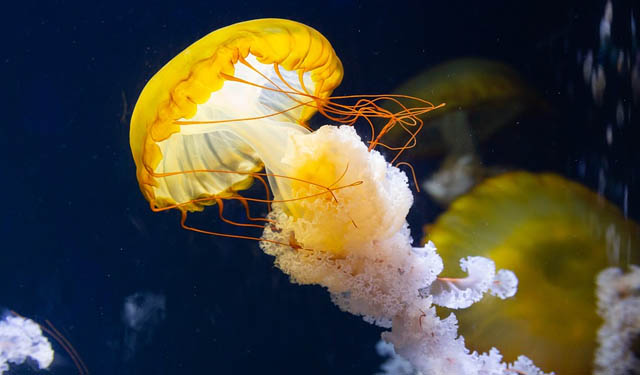The opportunities and advantages of jellyfish – As our oceans become increasingly dominated by jellyfish populations, many are advocating a novel solution – if you can’t beat them, eat them. This unusual approach to the jellyfish boom is gaining traction around the world, presenting both environmental and culinary opportunities.
Jellyfish populations have exploded in recent decades, largely due to overfishing, pollution, and climate change. These gelatinous creatures thrive in degraded ocean ecosystems, outcompeting and displacing fish and other marine life. Rather than viewing this as a problem to be solved, some experts suggest we should embrace the jellyfish takeover and start incorporating them into our diets.
Jellyfish are already a delicacy in many Asian cuisines, prized for their unique crunchy texture and subtle flavor. But this culinary tradition is now spreading globally, with chefs experimenting with jellyfish in innovative dishes. From jellyfish salads and stir-fries to jellyfish burgers and sushi, these nutritious invertebrates are proving to be surprisingly versatile.
Beyond their culinary appeal, consuming jellyfish also has environmental benefits. Harvesting them removes biomass from the ocean, potentially helping to restore balance to overrun ecosystems. Additionally, the process of preparing jellyfish for food helps remove some of the sting-inducing venom, making them safer for human consumption.
Of course, large-scale jellyfish harvesting raises concerns about sustainability and impacts on fragile marine food webs. Careful management and regulation will be essential to ensure this trend doesn’t create new environmental problems. However, proponents argue that embracing jellyfish as a food source is a better alternative than trying in vain to eliminate them.
Studies on jellyfish
Denmark
Kerteminde is a charming harbor town in Central Denmark with a stunning fjord surrounded by fields, hills, and forests.
It’s a haven for marine wildlife, but scientists from the University of Southern Denmark (SDU) are intrigued by one mysterious species – jellyfish.
The species Is booming just beneath the surface of the water, where this group of scientists jump into. In their snorkeling dive, they observe the jellyfish and collect samples.
These sea jellies aren’t very stingy, but their biomass here is so dense it harms other species.
Jamileh Javidpour, who has been studying jellyfish for over 20 years, says we don’t know enough yet to make such predictions.
“Apocalyptic scenarios of jellyfish bloom exist, and there are partly true stories because the presence of jellyfish might affect the entire ecosystem,” explains Jamileh Javidpour, associate professor at SDU.
“However, changes in the entire population need a kind of holistic view — what is the effect of other populations that are connected to this player of the food web together? So we need a kind of adaptive view to jellyfish bloom, which is still not existing.”
Jamileh Javidpour coordinated the GoJelly project, funded by the European Union. The project came up with a method to use jellyfish mucus, either natural or synthetic, to filter wastewater before it reaches the ocean.
“They take up particles very actively, capture these particles, and pack them in a biological mucus filter to get rid of them,” says Javidpour.
“And that is a pattern that we can learn from nature to come up with natural solutions.”
Italy
In Italy’s southern Apulia region, researchers at the Institute of Sciences of Food Production in Lecce are experimenting with turning jellyfish into plant fertilizer.
They start with frozen sea jellies and use vacuum drying to convert them into white powder.
Besides salts, this powder contains valuable amino acids, minerals, and other nutrients present in jellyfish that can be readily absorbed by plants.
Experiments show that plants grow better on jellyfish nutrients compared to a substrate with just salts.
According to Stefania De Domenico, Functional food researcher, CNR-ISPA, there is a clear difference in plant growth.
“This one is more lush, compared to the control sample, which has the same concentration of salts, but plants there are much more stressed and therefore drier.”
Jellyfish could even help cure diseases
Although still in the very early stages of research, scientists have discovered bioactive compounds in jellyfish that can trigger the death of breast cancer cells in experimental conditions.
“The extracts of these jellyfish have anti-proliferative activity on human cell cultures. We have observed that they can reduce the proliferation of cancerous cells while not affecting non-cancerous cells,” says Antonella Leone, a senior researcher, at CNR-ISPA.
Researchers, led by Antonella Leone, have developed a safe method to preserve jellyfish without using the aluminum salts that are common in Asia, but considered harmful in Europe.
Instead, they propose using calcium salts, which are safe to eat and preserve the jellyfish’s texture better.
The researchers teamed up with chefs to make a cookbook with jellyfish recipes. But before jellyfish can be served to the public, they need to be officially approved as food.
“What is required is authorization from the European Food Safety Authority to ensure we provide a safe product to consumers. Additionally, we must carefully study the entire process, from fishing to preparation, to ensure it is safe and sustainable.”
Sustainability is key
While jellyfish blooms are increasing in seas like the Mediterranean, researchers caution against large-scale fishing of these diverse species.
According to Dr. Leone, there is still a lack of knowledge about these gelatinous creatures and their unique life cycles.
However, surveys and samplings are ongoing in the seas around the planet.
In the meantime, any jellyfish-derived compounds used by the industry could be synthesized or based on sustainable production methods such as jellyfish aquaculture.
Removing too many jellyfish from our oceans before fully understanding them could put their ecosystem on a slippery slope, potentially causing more harm than good to the marine environment.
As the world grapples with the challenges of a changing ocean, the rise of jellyfish presents both an ecological crisis and a culinary opportunity. By adapting our diets to include these abundant creatures, we may be able to find a tasty solution to an otherwise troubling problem.
The opportunities and advantages of jellyfish








